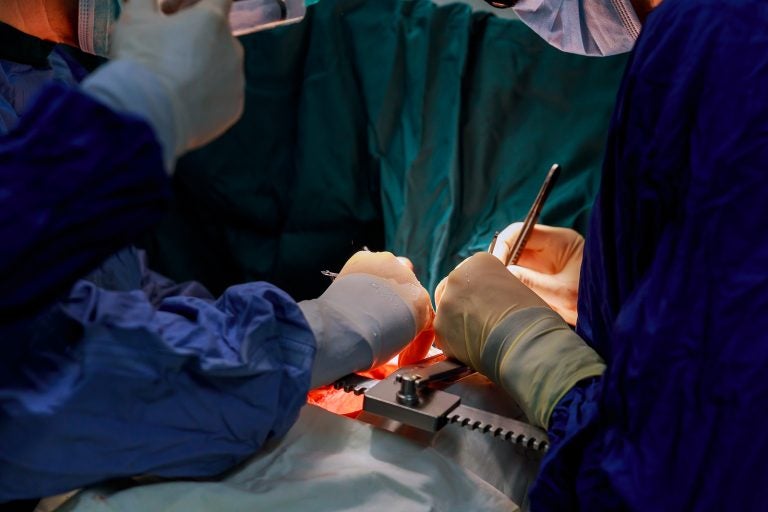Penn researchers find transplant potential in hepatitis C-positive hearts
Organs that once would have been rejected were successfully used in uninfected patients by Penn surgeons in a clinical trial.

(ungvar/Bigstock)
A team of Penn surgeons has successfully transplanted hepatitis C-infected hearts into uninfected patients and then cured them of the virus, according to a new study published by the American Journal of Transplantation.
The clinical trial — which tested the safety of hepatitis C-infected donor organs — included 10 transplant patients. Nine survived, and one died due to factors unrelated to hepatitis C, according to the lead co-author, physician Peter Reese.
“All 10 responded rapidly to antiviral therapy despite the fact that they were very immunosuppressed,” Reese said. “And we saw very little in the way of adverse events that were likely related to the virus or related to the therapy.”
If confirmed, the findings could help expand the donor pool for patients in need of life-saving heart transplants, Reese added.
“It’s not going to solve the problem that we don’t have enough organs,” he said. “But I think for those 200, 400, 500 patients who get a heart transplant, it’s going to change their whole life.”
Why hep C organs were banished
This isn’t the first time hepatitis C has appeared in the world of organ transplants.
The blood-borne virus saw its heyday in the 1960s through 1980s, thanks in part to untested blood transfusions and organ donations. (Infection screenings were established in the 1990s.)
According to Penn cardiologist Rhondalyn McLean, who co-led the study with Reese, some transplant centers continued using hepatitis C-infected organs even after screenings were established.
“Prior to the 2000s, we thought actually these would be fine hearts to use as donors,” McLean said. “Because the average heart will last about anywhere from 12 to 15 years, and hepatitis C doesn’t tend to cause a problem for at least 30 years or so.”
In other words, hepatitis C moved slowly enough that it posed little to no immediate threat to organ recipients.
That notion changed in 2006, with the publication of a study showing that recipients of hepatitis C-infected hearts suffered, in some cases, double the mortality rate of other patients.
Almost overnight, the practice was completely abandoned, said Reese.
“If there was any donor with hepatitis C, every center in the United States would refuse to accept it,” he said. “And so what we knew was that organs from donors and hepatitis C were a bad proposition and no one should use them.”
Hepatitis C primarily attacks the liver, and over time can cause fatal damage such as cirrhosis or liver cancer. For years, it was also chronic and incurable. But in 2013 — amid an exponential rise in infection rates associated with IV drug use — the FDA approved the first in a string of antiviral drugs capable of curing hepatitis C.
“I feel like the identity of this virus and this disease changed completely once new treatments came on the horizon,” Reese said. “We realized that hepatitis C was no longer this kind of disastrous condition, but more a problem that could be overcome.”
Overcoming the problem
Almost immediately, Reese and his colleagues started thinking about what these drugs could mean for organ transplants.
For the most part, hepatitis C-infected organs had been cut out of the picture, except as donations for hepatitis C-positive transplant recipients.
“There were thousands of organs being discarded every year, literally buried in the ground,” Reese said. “We were one of the first groups to propose that these organs were a valuable resource.”
Previous research had shown that hepatitis C-infected organs led to all kinds of complications, including increased mortality. Reese and his colleagues wanted to know if they could prevent that damage using these new antiviral drug treatments.
“So the idea is that, as quickly as you can, to cure the hepatitis C so that it won’t have a systemic effect on the patients,” said study co-author McLean.
If the trials succeeded — yielding results similar to uninfected organs —they could open up a significant new pool of donor organs.
“The lost opportunity is fairly large,” Reese said. “So like in 2016, 17 hearts from donors who tested positive for hepatitis C were transplanted, and 644 were discarded.”
Compare that to the number of patients who died in 2017 while waiting for heart transplants: just over 600.
But before Reese and his colleagues could begin their trial, they had to convince oversight committees, regulators — and most of all, patients — that experiments requiring potential infection with chronic and serious disease were not only safe, but potentially life-saving.
“It required the coordination of dozens of people,” Reese said. “There were some who said, ‘This is a good idea — we should go after this.’ And there were others who said, ‘I’m worried that you’re going to harm my patient. Why would I do this with you?’ ”
To date, there have been five other studies looking at the ability of antiviral drugs to mitigate the risk presented by transplanting a hepatitis C-infected organ — all successful. But they were also small, and only one other had focused on heart transplants. There was plenty that could go wrong.
“The big issue with transplantation specifically is that the recipient gets a new infection at the same time that we’re giving them very strong immunosuppression medicines,” Reese said. “So the concern is that you’re introducing a new infection at a time that the recipient’s body is really unable to fight it off.”
In which case, they worried, the antiviral drugs might not be powerful enough to overcome the hepatitis C. That was troubling, even on a temporary basis, because of the damage the virus could do.
“One big concern would be that the virus could cause acute liver failure, which can lead to death,” Reese said. “There’s also damage to the kidney from inflammation from the virus, or damage to the transplanted heart itself. Inflammation in the blood vessels that feed the heart, and possibly damage to the heart function.”
Choosing participants
To minimize the risk, team members used narrow criteria to choose their 10 subjects. They excluded patients with illnesses or substance-abuse issues that could compound the risk to their livers. They also actively pursued subjects who might otherwise die before receiving new hearts.
In the end, all 10 participants had end-stage heart failure, which, according to McLean, boasts a one-year mortality rate of 60 percent.
Their first subject was Tom Giangiulio, a fiftyish New Jerseyan who had spent over two years on the transplant waiting list. Giangiulio had type O blood and was also big in stature, two characteristics that made it harder to match him with a heart.
By the time McLean approached him in March 2017, Giangiulio had undergone a rapid decline.
“My heart function was dropping,” he said. “My heart pressure was moving up, my fluid volumes were getting higher — things were not looking good.”
Giangiulio’s worsening health had succeeded in bumping him up in the transplant waiting list — but there were still five other patients ahead of him.
So he listened to McLean’s pitch with an open mind.
“I found it very intriguing,” Giangiulio said. “I immediately thought that this might be my only shot at surviving.”
Three months later, Giangiulio got his transplant — a heart infected with hepatitis C.
On the third day after his surgery, the team tested Giangiulio for hepatitis C and found that he’d been infected. So they started him on a 12-week course of the antiviral medication elbasvir/grazoprevir. (They waited till the third day to avoid complications between the immediate post-transplant recovery and hepatitis C treatment.)
For Giangiulio, it worked — he received a lifesaving heart transplant, and was cured of hepatitis C in the weeks and months after.
The other nine subjects in the trial had similar responses — all tested positive for hepatitis C by the third day after their transplants, and eight were cured by the antiviral regimen. The final subject was also cured of hepatitis C, but died several months the transplant due to organ rejection.
Reese said that the results are encouraging, but that more research — offering a greater diversity of subjects, disease subtypes, and medications — will be needed to draw larger conclusions.
Nevertheless, Deepali Kumar — an infectious-disease expert and former board member of the American Society of Transplantation — said the study is important for two reasons: First, because it shows that patients on transplant waiting lists are willing to accept hepatitis C-positive organs; and second, because it’s one of the first studies to look at heart transplants and hepatitis C.
“Heart transplants are generally more immunosuppressed than other organs (for example, kidney or liver transplants), and the need for an organ can be quite urgent,” said Kumar, who was not involved with the Penn study. “Therefore, it is important that such studies be done in all different organ-transplant types.”
Both Kumar and Reese agreed that, while the research is still young, it could be as little as five years before the transplantation of hepatitis C-positive organs becomes standard practice.
“Hep C-positive organs have traditionally been discarded,” Kumar said. “So being able to use them safely is a great scientific advance.”
Editor’s note: This story has been updated to reflect the correct gender of a subject in the study.
WHYY is your source for fact-based, in-depth journalism and information. As a nonprofit organization, we rely on financial support from readers like you. Please give today.




